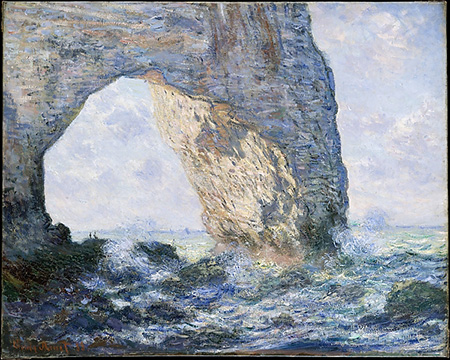
Continuing through December 31, 2017
Claude Monet's fascination with light as it alternatively dissolved and revealed the cliffs at Etretat, the Rouen Cathedral, haystacks, the Seine, the Thames at Westminster, poplars and the Gare St. Lazare and finally the water lilies at Giverny, is front and center in this exquisite and intimate exhibition, "Monet’s Etretat: Destination and Motif." Featuring two of Monet's ethereal paintings of the cliffs at Etretat on loan from the Metropolitan Museum of Art, also included are two brilliant paintings by American painters who utilized light in a different way, sometimes more structured, sometimes more esoteric. "Sunset, Etretat" (1892) by George Inness and "The Cliffs at Etretate" (1890) by William Henry Lippincott are on loan from the Terra Foundation of American Art. Basically a small fishing village and a quiet seaside destination, Etretat is notable for its dramatic cliffs, including Porte d'Aval, Porte d'Amont and Manneporte, which attracted Monet for their nuanced textures and monumental forms.
The exquisite cliffs dissolve into a bejeweled sea in the particularly dazzling “The Manneporte (Etretat)” (1883). The painting has everything; a dramatic and sculptural image of the cliffs looming out of the sea; the glimmering of light on a sea that is almost pointillist as it disappears and reappears; and the luminous play of white, grey and blue hues underlined with purple shadows on the rock formation as the sun changes position. The sea could have swallowed the delicate cool color palette of the imagery as white caps accent the waves, or the sky as its cerulean blues change and fluctuate. But the cliffs have an eternal presence that anchors the entire composition.
Monet’s stunning view of "The Manneporte Near Etretat” (1886) refines the liquid light of the sea and sky, and captures the intricate nuances and powerful scope of the cliff. Perhaps painted near sunset, the pink light reflects off the cliff, the waves and the sky, the whole scene looks like it is lit from within. Monet often worked on several different canvases at the same time in the various series documenting the changing light, as witnessed by the writer Guy de Maupassant: "The artist walked along the beach, followed by children carrying five or six canvases representing the same subject at different times of the day and with different effects. He took them up and put them aside by turns according to changes in the sky and shadows." In this glowing painting, the cliffs gain monumentality as the water and sky are depicted in a fantastic array of cool blues, greens, purples, and warm pinks, grey and orange.
Many American landscape painters and Impressionists studied in Europe, and French plein air techniques and the concentration on light and its mysteries started to permeate American painting processes. Inness visited Etretat on his third trip to Europe in 1874 and created more than twenty views of the area with its dramatic rock formations. He painted "Sunset, Etretat" much later in his studio in 1892, perhaps from a sketch. The painting shows a turbulent, rocky and dangerous sea, where a boat is tossed around in the water in disarray. Caught at the moment of a fiery and golden sunset, the entire scene is awash in an eerie light that emphasizes the spiritual elements of a storm at sea and the fragility and fury of nature. The contrast between Iness’ mystically informed space and Monet’s recording of light is instructive.
In “The Cliffs at Etretate," American genre and portrait painter Lippincott chose to depict the tranquility of men working near a fishing boat on the sand framed by the beautiful white and gold cliffs of Etretat. The sea, sky and sand also reflect the pure, yellow light that drenches the landscape in the limpid hues of a sunny day. The delicacy of the scene suggests that he painted en plein air to catch the immediacy of the scene.
The occasion of the two sparkling Monet paintings of the cliffs of Etretat is a cause for celebration by art lovers. This pair of treasures from the Met show the brilliance of Monet and his unerring eye for the poetry of light and shadow, along with his deep and abiding influence on American Impressionism and beyond.
